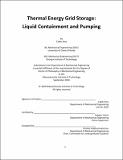| dc.contributor.advisor | Asegun Henry. | en_US |
| dc.contributor.author | Amy, Caleb(Caleb A.) | en_US |
| dc.contributor.other | Massachusetts Institute of Technology. Department of Mechanical Engineering. | en_US |
| dc.date.accessioned | 2021-01-05T23:11:47Z | |
| dc.date.available | 2021-01-05T23:11:47Z | |
| dc.date.copyright | 2020 | en_US |
| dc.date.issued | 2020 | en_US |
| dc.identifier.uri | https://hdl.handle.net/1721.1/128992 | |
| dc.description | Thesis: Ph. D., Massachusetts Institute of Technology, Department of Mechanical Engineering, 2020 | en_US |
| dc.description | Cataloged from student-submitted PDF of thesis. | en_US |
| dc.description | Includes bibliographical references (pages 149-158). | en_US |
| dc.description.abstract | As the cost of renewable energy falls below fossil fuels, the key barrier to widespread sustainable electricity has become availability on demand. Energy storage can enable dispatchable renewables, but only with drastic cost reductions compared to current batteries. In this thesis, I investigate an electricity storage concept that stores electricity as sensible heat in an extremely hot liquid (>2000°C) and uses multi-junction photovoltaics (MPV) as a heat engine to convert it back to electricity on demand hours, or days, later. In addition to a technoeconomic analysis, this thesis focuses experimentally on heating, liquid containment, and pumping. The transfer of the storage liquid is key because it enables conversion to and from electricity and compact, efficient heat transfer. However, operating at these extreme temperatures introduces many practical challenges, so several novel solutions related to containment and pumping are investigated including high-performance heaters, sealing a large multi-part tank with affordable materials, and pumping above 2000°C. The key result is that although affordable silicon can be contained in affordable graphite and pumped at these temperatures, temperature variation in the system causes it the graphite infrastructure to rapidly dissolve and ultimately fail in a matter of hours. Alternative embodiments are proposed with recommendations on areas of future work. The key takeaway from the technoeconomic modeling is that integrating low-cost thermal storage with an inexpensive heat engine can enable an economical approach to electricity storage, even without high round trip efficiencies. Thus, despite the challenges, future work is warranted. | en_US |
| dc.description.statementofresponsibility | by Caleb Amy. | en_US |
| dc.format.extent | 158 pages | en_US |
| dc.language.iso | eng | en_US |
| dc.publisher | Massachusetts Institute of Technology | en_US |
| dc.rights | MIT theses may be protected by copyright. Please reuse MIT thesis content according to the MIT Libraries Permissions Policy, which is available through the URL provided. | en_US |
| dc.rights.uri | http://dspace.mit.edu/handle/1721.1/7582 | en_US |
| dc.subject | Mechanical Engineering. | en_US |
| dc.title | Thermal energy grid storage : liquid containment and pumping | en_US |
| dc.type | Thesis | en_US |
| dc.description.degree | Ph. D. | en_US |
| dc.contributor.department | Massachusetts Institute of Technology. Department of Mechanical Engineering | en_US |
| dc.identifier.oclc | 1227040682 | en_US |
| dc.description.collection | Ph.D. Massachusetts Institute of Technology, Department of Mechanical Engineering | en_US |
| dspace.imported | 2021-01-05T23:11:46Z | en_US |
| mit.thesis.degree | Doctoral | en_US |
| mit.thesis.department | MechE | en_US |
